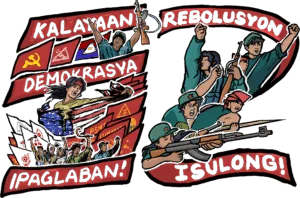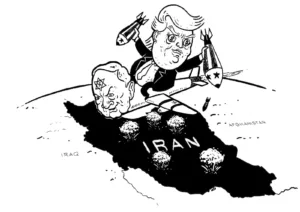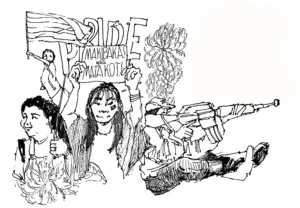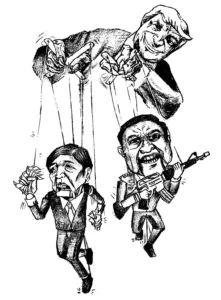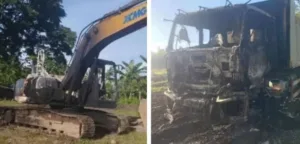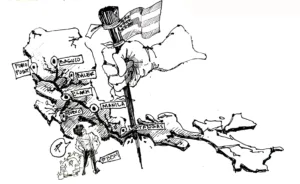By FIDEL V. AGCAOILI
Chairperson, NDFP Human Rights Committee
NDFP Negotiating Panel
Of course, Pierre Rousset does not want any discussion on the real nature of these break-away factions. For him, the “real issue is the right of a pluralist and revolutionary Left to exist in the Philippines.” Here, we have the real agenda of Trotskyite Pierre Rousset. What is after all the life’s mission of any dyed-in-the-wool Trotskyite but to applaud and instigate splits within the revolutionary movement? The original Trotsky advocated “freedom of factions” to instigate splits inside the Communist Party in Russia. The new Trotskys advocate “pluralism” to instigate splits in the Left. What Pierre Rousset actually wants is a fragmented and collaborationist “Left”.
If the Philippine revolutionary movement led by the Communist Party of the Philippines (CPP) were so inhuman as French Trotskyite Pierre Rousset wishes to depict it in his latest diatribe against the movement and the CPP, “The CPP-NPA-NDF Hit List – A Preliminary Report”, why is it that this same movement continues to get wide support from the people and is considered by the Philippine puppet state as the biggest threat to its reactionary rule? The Filipino people’s own judgment is a more reliable yardstick for judging the Philippine revolutionary movement rather than some arm-chair activist long ensconced as a staffer in a cozy office at the European parliament.
Pierre Rousset has made a career out of attacking and trying to discredit the Philippine revolutionary movement. Among others, he has written 3 articles focusing on the so-called “assassination policy” of the CPP making general assertions bereft of any credible evidence. His latest piece, the fourth on the subject, which he considers still “preliminary” merely repeats his old assertions. His lies have no effect in the Philippines and it would have been all right just to ignore them. But we take the time to answer him because his lies can mislead people abroad who may not have the benefit of knowing the facts on the ground.
While Pierre Rousset rants about the non-existent “assassination policy” of the CPP, the Philippine state has actually gone berserk assassinating leaders and activists of open mass organizations and political parties tagged by the Philippine military as “CPP fronts”. From January to March alone this year, 34 leaders and members of progressive organizations including a priest have been killed in death-squad-style operations and five others kidnapped and are still missing up to the present. A well-respected lawyer serving as chief legal counsel for the National Democratic Front of the Philippines (NDFP) in the peace negotiations between the Government of the Republic of the Philippines (GRP) and the NDFP, UN ad litem Judge Romeo T. Capulong, has been the target of an assassination attempt.
One might wonder why none of the groups anointed by Pierre Rousset as “independent revolutionary Left parties” have been attacked by the Philippine military. One might also wonder why none of them has raised even a squeak against the latest spate of state-sponsored killings.
But things begin to clear up when an armed grouping considered by Pierre Rousset as an “independent revolutionary Left party”, RPM-P/RPA-ABB, boasts of having carried out the cold-blooded murder of a BAYAN MUNA leader, Romeo Sanchez, in northern Luzon. This same “independent revolutionary Left Party” openly admitted recently to have coordinated with the Philippine Army in attacking a New People’s Army (NPA) camp in Negros, southern Philippines. Talk of “independence”!
“The Global Picture”
This Pierre Rousset is quite a tricky fellow. He focuses on the so-called “assassination policy” of the CPP under the heading “The global picture”. If you are not careful you would think that the CPP does nothing except kill and threaten its ideological opponents. To really get the global picture about the CPP and the Philippine revolution, we invite the reader to visit the website: http://www.philippinerevolution.net/.
Many of the so-called “independent revolutionary Left Parties” mentioned by Pierre Rousset sneaked out of the Communist Party of the Philippines when the CPP decided to rectify erroneous policies in the 80’s that had resulted in the weakening of the revolutionary movement. These errors consisted of pushing for early military victory through artificial means like combining mass protest actions in the cities with burning of buses and bombing of government installations to “create a revolutionary crisis”, and embarking on a premature regularization of the people's army and unsustainable kind of intensifying of guerrilla warfare in the countryside. The Party also decided to denounce and rectify the so-called anti-DPA campaigns such as Kampanyang AHOS that victimized many Party members and mass activists.
The main proponents behind these errors like Arturo Tabara, Romulo Kintanar, Filemon Lagman, Ricardo Reyes and Benjamin de Vera refused to follow the Party’s decision to criticize and repudiate these errors and separated themselves from the CPP with their factions and stole CPP assets. Upon leaving the Party, these factions tried but failed to form a common front. Apparently, the only thing they had in common was their opposition to the CPP.
Of course, Pierre Rousset does not want any discussion on the real nature of these break-away factions. For him, the “real issue is the right of a pluralist and revolutionary Left to exist in the Philippines.” Here, we have the real agenda of Trotskyite Pierre Rousset. What is after all the life’s mission of any dyed-in-the-wool Trotskyite but to applaud and instigate splits within the revolutionary movement? The original Trotsky advocated “freedom of factions” to instigate splits inside the Communist Party in Russia. The new Trotskys advocate “pluralism” to instigate splits in the Left. What Pierre Rousset actually wants is a fragmented and collaborationist “Left”.
The general policy of the CPP with regard to these breakaway groups has been to struggle with them ideologically and politically to minimize the damage they can create in sowing disunity and confusion among the people in their life and death struggle against the reactionary ruling system in the Philippines. It is of course a different matter if some of these groups or individuals belonging to these groups engage in criminal activities, such as acting as spies or as death squads for the Philippine military intelligence services.
Let us now take up Rousset’s favorite cases:
1. Arturo Tabara and his group, the RPM-P/RPA-ABB.
The RPM-P/RPA-ABB is a merger of a breakaway group in Negros Island that took the name Revolutionary Proletarian Army (RPA) and a splinter of the Alex Boncayao Brigade (ABB) that used to operate in Metro-Manila under Filemon Lagman and Nilo de la Cruz.
The ABB under Lagman and de la Cruz (with the blessings of Romulo Kintanar, who was then a high official of the NPA) carried out indiscriminate killings of more than 200 policemen (including traffic policemen). The reactionary military and police took advantge of this error to make a violent counterattack on activists and leaders of popular organizations of the urban poor and Bagong Alyansang Makabayan (BAYAN) in Metro-Manila. Lagman and de la Cruz also promoted the line of insurrection in the cities that consisted of combining mass protest actions with burning of buses and bombing of public installations.
After leaving the CPP, the two parted ways and quarreled over the division of some 80 million of pesos of bribe money from a real estate developer for their role in facilitating the ejection of urban poor families from a piece of real estate the developer wanted to convert into a commercial area. This quarrel led to the killing of Lagman. Despite all evidence, Pierre Rousset insists that the CPP is responsible for Lagman’s murder. We advise him to ask the brother of Filemon Lagman himself who he thinks is the real killer.
Arturo Tabara’s RPA on the other hand has been acting as special death squads of the state and as armed goons for big landlords in Negros, the biggest being the old Marcos-crony Eduardo Cojuangco. This group recently boasted of killing 9 NPA fighters (actually 2 NPA fighters were killed) in an attack on an NPA camp coordinated with the Philippine Army’s 61st Infantry Battalion. This attack is part of ongoing military operations of the Philippine Army intended to clear the way for the resumption of operations of foreign mining companies in the area. The peasant masses are opposed to the operation of these mining companies because of the destruction they bring on their farms and fishing grounds.
The RPA-ABB has been conveniently “deputized” by the governor of Negros Oriental Jorge Arnaiz as “forest guards”, in fact, special death squads, to protect — not the forest — but the foreign mining companies. A human rights organization in Negros has called the RPA-ABB a “special armed gang” of Governor Arnaiz (a local warlord in his own right) and the paramilitary arm of the Philippine Army in its “counter-insurgency” operations.
The RPA-ABB has also claimed responsibility for the killing of Romeo Sanchez on 9 March 2005 in Baguio City. Sanchez was the regional coordinator of Bayan Muna political party tagged by the military as a “CPP front”. He was a media man and the director-general of the UNESCO has condemned the killing and other unsolved killings of journalists in the Philippines.
As for Arturo Tabara, top dog of the RPM-P/RPA-ABB, he had become an agent of the Intelligence Service of the Armed Forces of the Philippines (ISAFP). As a special psy-war agent, he belonged to the enemy armed forces and under international law was an armed combatant and a legitimate military target. Any armed companion of his also became liable in any shooting situation.
2. Conrado Balweg and the Cordillera People’s Liberation Army (CPLA).
Balweg left the NPA and formed the CPLA after the overthrow of Marcos in 1986. He came under the influenced of Agapito Aquino, brother-in-law of Corazon Aquino. He later surrendered to the Government of the Republic of the Philippines (GRP) and his CPLA was integrated into the GRP’s paramilitary, the Citizens’ Armed Forces Geographical Unit (CAFGU). As part of the CAFGU, the CPLA conducted military operations against the NPA and abused the people, even killing some tribal leaders. Balweg and his CPLA naturally became legitimate military targets. The CPLA has now reportedly fragmented into four smaller factions.
3. Leopoldo Mabilangan.
He was never head of the NPA Banahaw Command as Pierre Rousset asserts. He became its spokesperson during negotiations for the release of five army officers taken as prisoners of war by the NPA. He later deserted the NPA and surrendered to the GRP when he was being investigated for harboring the Red Scorpion Group, a kidnap-for-ransom gang. A local politician-warlord took him under his protection. He turned into an armed government agent and was active in psywar campaigns calling for the surrender of NPA fighters and in setting up government-funded fake cooperatives to draw the peasant masses away from the revolutionary struggle. Eduardo Borromeo, a friend of Leopoldo Mabilangan, was engaged in similar activities and was an armed enemy of the NPA.
4. The AKBAYAN/Peace Foundation/Task Force Bondoc Peninsula grouping.
During the campaign period for the 2004 elections, AKBAYAN joined in the chorus of red-baiting against progressive party-lists — Bayan Muna, Anakpawis, Anak ng Bayan, Gabriela Women’s Party, Migrante Party List, and Suara – orchestrated by the right-wing bureaucrat National Security Adviser Norberto Gonzales.
Threatened by the strong showing of these party-lists in pre-election surveys, the Macapagal-Arroyo regime did everything to disenfranchise and discredit these party-list groups. Norberto Gonzales personally went to the office of the GRP Commission on Elections and tried to block the registration of these parties on the pretext that these were “CPP front organizations.” In the course of the election campaign, leaders and activists belonging to these party-list groups suffered harassment and physical attacks from the Philippine Army and government-backed paramilitary groups. 14 were killed (10 from Bayan Muna, 3 from Anakpawis and 1 from Gabriela), 3 Bayan Muna leaders have disappeared, one office was raided, and another nearly burned through arson. GRP soldiers intimidated people especially in the countryside from voting for these progressive party-list groups and openly campaigned for AKBAYAN and other administration parties. The military reported having killed 117 people in the countryside and alleged that 55 of them were political supporters and 62 were members of the New People's Army.
The Peace Foundation/Task Force Bondoc Peninsula was set up by Manuel Quiambao who used to be in the Peasant Secretariat of the CPP. While in the CPP, he pushed for “left” tactics of land occupations and peasant uprisings that were premature and unsustainable. After he left the CPP, he veered to the right begging the landlord-dominated Philippine government to distribute land through the Comprehensive Agrarian Reform Law (CARL) passed in 1987 during the term of big-landlord Corazon Aquino. Her family owns the Hacienda Luisita that has escaped expropriation through the "stock option" swindle and other loopholes deliberately inserted by landlord congressmen in the CARL.
Peace Foundation/Task Force Bondoc Peninsula has been trying to organize peasants in the Bondoc Peninsula in Southern Quezon around the promise of "land" transfer through the CARL. Surely, they are just out to hoodwink the peasant masses. (In fact, "certificates of land transfer" and "certificates of land ownership amortization" previously distributed are now being nullified simply through land reclassification on a national scale.)
Dioscoro Tejeno, whom Rousset describes as a peasant leader, is a member of a paramilitary unit attached to the 74th Infantry Battalion of the Philippine Army based in Barrio Ajos, Catanauan, Quezon in the Bondoc Peninsula. A barrio official has testified that he saw Dioscoro Tejeno in June 2004 in Barrio San Vicente, San Narciso, Quezon, wearing fatigue uniform and carrying an M-16 rifle in the company of 20 soldiers belonging to the 74th IB/PA.
Dioscoro Tejeno’s own niece, Prescy Tejeno Melendrez has testified to having seen Disocoro together with other members of the “peasant association” of the Peace/Bondoc Development program, Roger Tejeno, Jesus Tayactac, Eugene Vivar and Herman Valiente, carrying pistols and rifles placed inside sacks of rice.
These four are now facing the charge of murder in the GRP Municipal Circuit Trial Court of San Narciso-Buenavista for the killing of Paulo Tejeno, Dioscoro’s own brother, whom Dioscoro has falsely accused of being an NPA member. The victim was “expelled” in 2001 from the Peace/Bondoc Development Program “peasant association” by Dioscoro and company because he criticized the latter’s anti-social activities like the slaughter of the work-horse of a barrio resident and their cattle-rustling activities. Dioscoro and the four suspects in the murder of Paulo Tejeno are now reportedly hiding in the office of the Peace Foundation in Metro-Manila.
Rousset mentions the cases of Lito Bayudang and Florente Ocmen, supposed officers of Akbayan killed by the NPA. According to reports we received, Lito Bayudan not “Bayudang” was a former NPA member who later became one of the ring leaders of the Red Vigilante Group, a paramilitary group of the Philippine Army. This paramilitary group also maintains links with the RPA-ABB. Florente Ocmen on the other hand was charged and found guilty by a people’s court in two rape cases. These are the types of people Akbayan touts as its officers – one a death squad member, the other, a rapist!
5. Romulo Kintanar.
He was an intelligence agent of the Manila government's military and police since 1992. As such he was a combatant in the ongoing civil war between the GRP and the revolutionary movement of the Filipino people, represented by the NDFP in peace negotiations between the GRP and the NDFP.
No less than GRP President Gloria Macapagal-Arroyo confirmed that Kintanar was an intelligence agent of the Manila government. The Philippine Star on 27 January 2003 reported in its banner story, NPA Admits Kintanar Slay: "President Arroyo confirmed that Kintanar was working as a government intelligence agent at the time of his assassination."
Earlier, on 23 January 2003, an official in Arroyo's Malacanang Palace said Kintanar was "a consultant of the Philippine National Police (PNP) and Armed Forces of the Philippines (AFP), but was drawing his salary from the Bureau of Immigration and Deportation (BID)" (Philippine Daily Inquirer, Breaking News, 24 January 2003, Communist Party Chief Blamed for Slay of Former NPA Head). He was also a security consultant to the National Electrification Administration (NEA) at the time of his death.
Efforts to recruit Kintanar into the military intelligence were successfully carried out in the period of March to August 1992 when PNP intelligence officer Col. Robert Delfin faked the arrest of his asset Ricardo Reyes, a renegade expelled from the CPP more than a decade ago, and put him in the same detention cell as Kintanar in order to turn him against the revolutionary movement.
After his release from prison through an amnesty program of the Manila government in September 1992, Kintanar made known his separation from the CPP. He started to work for the intelligence services of the GRP and also became thoroughly involved in the criminal world of corrupt military and police officers engaging in protection rackets, armed robbery, kidnapping and murder for hire, even putting up his own private security agency (Philippine Daily Inquirer, 24 January 2003, Ibid) as cover for his nefarious activities.
Kintanar, together with his uncle, Gen. Galileo Kintanar, former head of the Intelligence Service of the AFP (ISAFP) during the Marcos regime, was linked to the murder of movie star Nida Blanca and was known to facilitate transactions with the military and police for a fee. Two days before his death Kintanar was one of the special guests of PNP chief General Hermogenes Ebdane at the 12th founding anniversary of the National Capital Regional Police Office (NCRPO), hobnobbing with top police officers (The Philippine Star, 24 January 2003, Ex-NPA Chieftain Slain). Also another special guest was Arturo Tabara, who was the chieftain of the RPA gang, a security force of big landlord and Marcos crony Eduardo Cojuangco in Negros Occidental.
In 2000, after becoming security consultant to Gen. Alexander Aguirre, former President Joseph Estrada's national security adviser, Kintanar was designated project officer in an assassination plot against Prof. Jose Maria Sison in the Netherlands. He followed the direction of Gen. Panfilo Lacson, head of the PNP at the time. (Manila Times, 24 January 2003, Ex-NPA Chief Assassinated Inside QC Restaurant) He also took part in surveillance and other "counter-insurgency" operations by the military and police against the CPP and NPA.
At the time of his death, Kintanar was with two bodyguards and was personally armed with three guns: a .45 caliber pistol, an HK machine pistol and a Glock 9mm pistol (Philippine Daily Inquirer, 6 February 2003, Kintanar Lost Rolex, Cash, 3 Guns, Golf Set). As an intelligence agent of the GRP, he was always ready for combat against the revolutionary movement.
Kintanar was definitely a combatant. He was fully armed and dangerous at the time of his death. These facts are well known in the Philippines. But some groups and individuals abroad like Pierre Rousset would rather peddle lies than tell the truth about events in the Philippines in their vicious scheme to malign the Philippine revolutionary movement.
6. Marxist-Leninist Party of the Philippines / Rebolusyonaryong Hukbong Bayan (MLPP/RHB).
An armed grouping that broke away from the NPA and operates in some parts of Central Luzon. They have engaged the NPA in combat. The alleged “killings of unarmed organizers of MLPP/RHB” mentioned by Pierre Rousset are actually the result of armed encounters between MLPP/RHB and the NPA.
7. RPM-M/RPA.
A small breakaway armed group operating in a limited area in Central Mindanao. This is another anti-communist armed group similar to the RPM-P/RPA and the MLPP/RHB. Pierre Rousset’s Ligue Communiste Revolutionaire has bilateral relations with this armed group.
With regard to the other groups like Siglaya, Alab Katipunan, Bisig, BMP, IPD, Pandayan, Sanlakas, etc., the CPP wages ideological and political struggle in the nature of struggle of ideas vis-à-vis these groups. The CPP and its allied organizations go to the people to explain to them the dangers of reformism and “left” revolutionism advocated by some of these groups that can derail or hinder the further advance of the people’s struggle.
The diagram of counterrevolutionary and pseudo-progressive organizations and their international connections published in the December issue of Ang Bayan, the official news organ of the CPP, is part of the effort to explain to the members of the Party and allied organizations and to the Filipino people about the nature of these groups.
Walden Bello turned this diagram into a CPP “hit-list” and went into a frenzy, jet-setting all over the globe spitting poison against the CPP and red-baiting people’s organizations in the legal democratic movement. Pierre Rousset was quick to pick up the canard and add his own twists.
A word about Trotskyites. These pseudo-revolutionaries who have never led any real revolution try to insert themselves into the people’s movement by riding on popular issues. At worst, like Trotsky himself, they receive funds from the imperialists to specialize in penetrating progressive movements and attacking communist parties. They pretend to be Left when in fact they are Right.
A good example of Trotskyite counterrevolutionary activity is pretending to be for a broad movement like the ATTAC project in Europe. But the ultimate narrow objective of the Trotskyites is to bring the movement to a cul de sac of reformism and anti-communism. If only to lead people astray, they exaggerate expectations that the Tobin tax, a tax of 0.1-0.25% on currency trade around the globe would be collected by the state and spent for preventing global warming, disease and poverty.
They propose to ATTAC only a teeny-weeny bit of the transactions of finance capital and to leave the rest intact. A very fine proposal indeed to plead to the conscience of the monopoly bourgeoisie while making imperialist plunder palatable to the oppressed and exploited workers and peoples of the world! And yet the proposal is really a lot of hot air because it all depends on reformist begging which the monopoly bourgeoisie can ignore easily.
